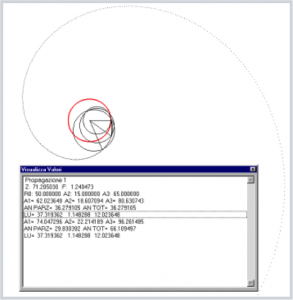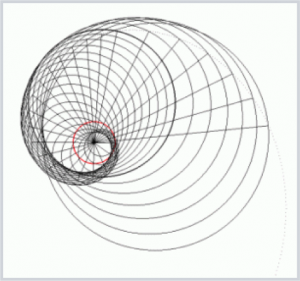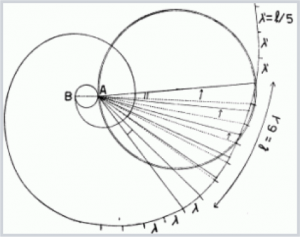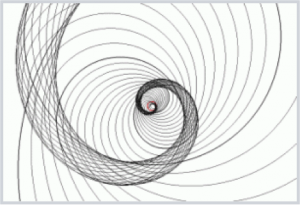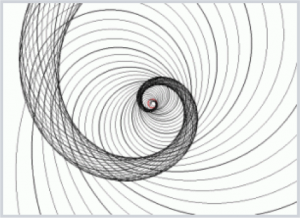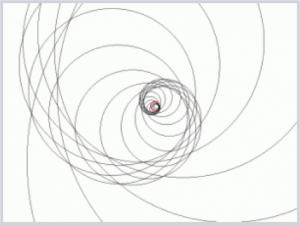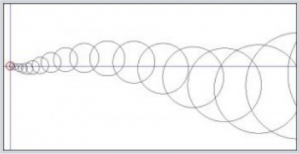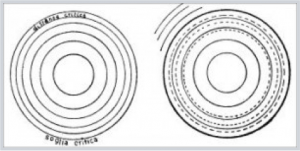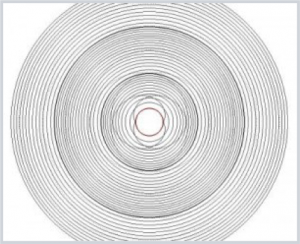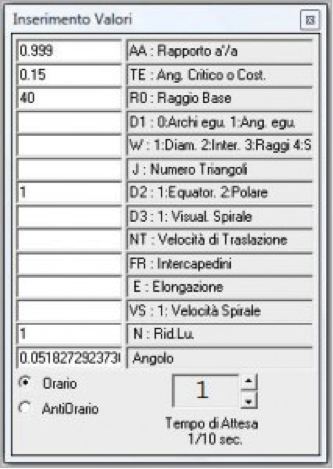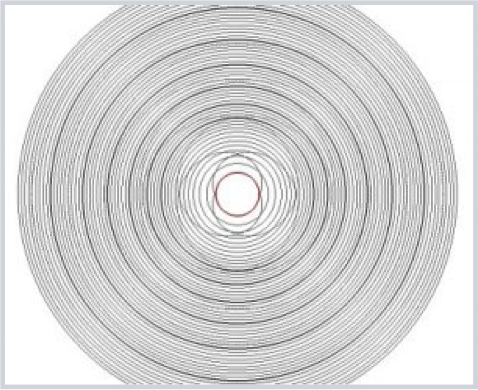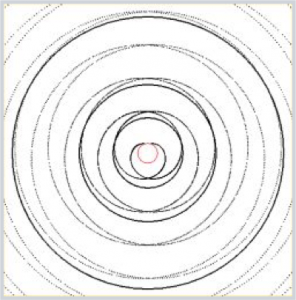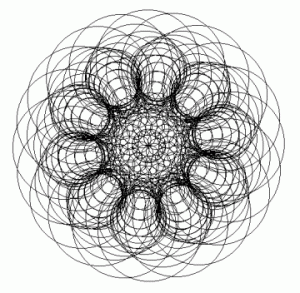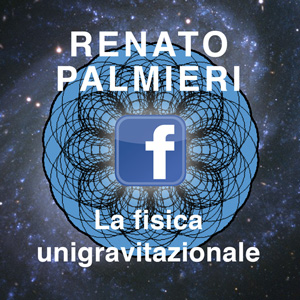Cap.3.6 Universal field phenomena: “undulatory composition”, “pulsation” and “inter incidence”.
- B) Pulsation
Pulsation in the eccentric propagation
- 1. The phenomena we will now examine are the proof of the abysmal distance that divides contemporary physics from the possibility for it to understand the slightest detail of the nature surrounding us. Readers will become even more aware of the urgency of ending the more than secular scandal of a “science” devoid of the very meaning of its own definition.
Let’s start from the first phenomenon. Current physics knows it only as a manifestation of certain very rare stars, characterised by very rare endogenous states, reason why they are called “pulsar”. On the other hand, we have previously clarified the mystery, proving that this is actually a field phenomenon which is absolutely universal and indispensable for the physical understanding of the bodies’ structure. Dealing with it more specifically, we will introduce the other fundamental phenomenon that current physics ignores in its equally structuring and universal function: the inter incidence between waves of different length and frequency, having the same centre of gravity in a complex body (and therefore not to be confused with those that get into composition, starting from distinct sources).
Simplifying, we will say that the second phenomenon is responsible for the growth of the structures for multiplicative reasons (twice, three times bigger … even by fractional factors), whereas the first one for exponential reasons (square, cube …, even for fractional powers). From this general enunciation it will be already clear – considering the total ignorance of official physics – the enormous importance of understanding the two phenomena, which are also closely related to each other.
In fact, while the inter incidence can occur in absence of pulsation, the inverse is only possible in theory, but pulsation usually involves inter incidence events.
We will see that the pulse phenomenon has its subatomic equivalent in the two other phenomena known as “Compton effect” and “black body radiation”. Once again the current physics reveals unable to understand the intimate correlations between events that occur on different levels and orders of phenomena. We will also point out that the quantum mechanics was precisely born in connection with this constitutional incapacity and carries its unmistakable burden.
- 2. As mentioned above, we will now give you the instructions to create figures 1 to 3 of chap. 1.9 with OLOPOIEMA and check its mathematical data in the appropriate window. As we did in the first chapters of Sect.3, we add a red circumference, which schematises a spheroid body in equatorial projection, where a gravitational propagation is produced with an exemplificative ratio a’/ a= 0.3. Another difference lays in the fact that, instead of the diameters of the waves, we will draw the bigger radii of the propagation and their spiral only (the spiral of the smaller radii are therefore omitted).
Subprogram PROPAGAZIONE, black colour:
- Enter the INPUTs just as in the INSERIMENTO VALORI table;
- Return with the mouse to AA: you will read at the bottom the corresponding “construction angle”: for a’/ a = 0.3, it equals 36.279105 degrees.
Click “AVANTI” up to the sixth wave after the first pulsation (Figures 28 a, b and c).
In fact, while the inter incidence can occur in absence of pulsation, the inverse is only possible in theory, but pulsation usually involves inter incidence events.
Z is the acute angle that a straight line tangent to the spiral forms with a radius in the tangency point. It transforms into a right angle when the spiral degenerates into a circumference, and becomes void when the spiral degenerates into a straight line. It is a necessary data for the mathematical correction of the spiral: OLOPOIEMA calculates it for each spiral.
F is the incremental factor of the linear elements of the spiral for each rotation equal to the architectural angle: this is the acute angle of the rectangular triangle inscribed into the spiral (with its vertex in the propagation barycentre, the centre of the body coloured in red), and it corresponds to the first “partial angle” that appears in the window (36,279°), calculated by OLOPOIEMA for each spiral based on the propagation ratio to a’/ a.
LU is the fixed length of each spiral arc cut off by the following radii. The third value on the same line is the constant increase of the biggest radius (R0 the first one, A1 the following ones) for each consecutive arc with LU length. The second value is LU/(A3’/ 2) and will then be needed afterwards (A3 is the diameter of each wave, sum of the largest and the smaller radius A2; A3′ is the first of the values of A3, the one on the second numeral row).
- 3. Creating fig. 28 it can be noticed that it passes in a), b) and c) through Figures 1-2 of chap.1.9. The radii following the first one cut the logarithmic spiral into arcs all linearly equal, whose angles with their vertex at the centre of the red circumference are therefore continually decreasing up to the criticality, set by us as an example at the value of 8° (input TE).
At that limit, two consecutive waves merge into one wave (“pulsation”) and those that follow behave just the same, so that, after the pulsation, imploded waves proceed with a double photon load and spaced out by double linearly arcs.
Once the pulsation and the instantaneous transfer of the gravitational load of two waves into one have occurred, along the following path the waves return to be detected as normal by the instruments, although their global intensity has doubled and with it the linear distance on the spiral. The instruments detect the turbulence of the explosion, signalling the energy peak only in the bands of criticality, as stated in § 3 of chap.1.9. We now need to exit leave the simplified scheme with which we have so far described the phenomenon, to deepen its geometric and mathematical aspect.
In the VISUALIZZA VALORI window, we scrolled the side cursor from the very top to the bottom to let observe the progressive decrease of the partial angle up to the value 7.77 smaller than the critical angle we fixed (8°). After the pulsation the partial angle increases temporarily and then decreases again towards a second criticality and a new pulsation. Meanwhile LU has doubled from 37.319 to 74.6387 and therefore also the other two values on the same line. The process carries on this way, indefinitely, mathematically reflected in the window step by step.
- 4. In § 3 of Chapter 1.9 we already mentioned that the phenomenon is more complex in natural reality. This is what we now explain more precisely, to overcome the simplification made at that time for obvious explanatory reasons.
The implosion of consecutive waves occurs because an excessive proximity of the entire spherical surface of subsequent waves overcomes the surface tension of the wave fronts, which breaks down causing the implosion of the one wave into the other. The same tension that normally separates subsequent waves causes that, after the moment of pulsation between two waves, those following along the spiral are pressed to fill the gap suddenly created in front of them, with a spacing that gradually decreases until the recovery of the normal wavelength λ (fig.29: also replicated from our first work Physycs of Unigravitational Field).
In this figure l is an exemplifying length, which would contain without the pulsation six waves of λ length, but on which only five waves are redistributed due to the pulsation. Hence these pass through the critically threshold spaced out by an angle slightly bigger than the critical one and therefore they do not undergo pulsation. After the threshold the distance between them is restored to a uniform average value λ’= l / 5. Meanwhile the waves that follow them, separated by the normal length now returned λ, also reached their critical threshold with an angle again critical between them, and then undergo a new pulsation. From all this it follows that the energy peaks perceived at the critical threshold are not immediately consecutive, but are spaced by a constant time interval, which is the period of the pulsation and which corresponds to the effective wavelength l = 6λ between the pulsed wavelengths of same level, to which the same incremental cycle applies (just as to those that did not undergo the pulsation), and so on indefinitely.
- 5. Let’s see graphically and mathematically, by means of the VISUALIZZA VALORI window the difference between the simplified procedure previously followed, where the wavelength doubles at every critical threshold, and that of fig. 29, where the wavelength increases more gradually of only a fraction of λ at every pulsation.
Subprogram PROPAGAZIONE, black colour;
- AA = 0.3; TE = 8; R0 = 15; D2 = 1; N = 1; Reset the other values.
- Implement ORARIO. Remove axes after centring.
Before starting, we observe that N is an integer dividing λ, so that fraction represents λ/N the increase of λ after the critical threshold: λ’= λ+λ/N. It follows that, if N=1, the increment of λ is the same λ, that is, λ’=2λ. We are still in the simplified procedure of Sect. 1.
- By clicking PLAY, the result will be our logo, reproduced in Fig.30.
If we repeat the process entering N=5, as in Fig.29, the increment of λ will be λ/5 after each pulsation and the pulsations will be more numerous for the same total rotation. The graphic result is shown in fig.31.
- 6. We should remember, as previously noted, that the waves imploding in a pulsation are not two consecutive waves, as in the demonstration scheme used so far, but a large number of contiguous waves involved in the phenomenon in a very extended group. So, every critical threshold in the field of a star thousands of light years far is actually a sphere of turbulence wide itself thousands of light years. And yet the total extension of such bands along the cosmic distances represents a minimal part of the intersidereal paths, so that the condition of an observer to be in a critical band in relation to the surrounding stars is statistically very rare: it follows the appearance of extreme rarity of the phenomenon itself.
- 7. Being closer to natural reality, Fig. 31 shows more clearly than Fig. 30 the phenomenon of growth by concameration with constant ratio of natural structures due to the constancy of the separating angle between successive pulsations. This constancy is to be evaluated on average and is of course the more regular the more accurate values and data are refined in the light of the proper natural processes. Field pulsation, therefore, is not only universal, but plays a key role in the shaping of material structures, more visibly in biological ones.
- 8. It will be for readers to use the VISUALIZZA VALORI window according to the instructions given above to recognise the phenomenon in the mathematical data, observing the inevitably cyclical return of the criticality and the progressive increase in the wavelength at each pulsation. They will also capture the average constant angular difference between pulsations, deducting it from the total angle of rotation at the critical value point of the partial angle and subtracting it from the total angle of the previous criticality. They can also usefully change the critical angle data (input TE), whose decreasing decreases the number of pulsations, and the input N, whose increasing increases them.
- 9. Let us transform the average constancy of the separation angle between the pulsations, as in the previous two paragraphs, in an exact constancy, as is usually the case in nature, at least for regular structures such as biological ones. The procedure is as follows:
From the VISUALIZZA VALORI window relevant to fig.31 we note that the average separation angle between the subsequent pulsations is about 31°, resulting from a cyclic series of three values, one slightly above 25° and two around 33.5°.
Let us use again Olopoiema’s PROPAGAZIONE, entering among the inputs of previous § 5 the value of 31 (degrees) in TE (no longer critical but constant angle) and 1 in D1, to draw a structure with equal central angles instead of a structure with equal rectified spiral arcs (fig.32).
Fig.32 represents the mathematical and geometric normalisation of the universal pulsation phenomenon and shows the law of increase of infinite natural forms, which can be configured in very varied ways by changing numerical parameters as you like: this will be seen more particularly in the section of this title dedicated to “morphogenesis”.
It confirms what we said at the beginning, that the official science is irremediably far from being able to find in nature any slight correspondence to its quiddities, since it is incapable of recognising a fundamental phenomenon of nature itself, such as pulsation, and such the other one we will deal with shortly: the undulatory inter incidence.
By adding to inputs of fig.32 the value 10 for NT (field centre translation speed) we will obtain fig.33, which reproduces the structural trend of fig.4 of chap.1.6, namely that of the right horn of an animal.
The pulsation in concentric propagation
- 10. Figure 34 is the equivalent of fig.29 (§4) as regards the pulsation in the concentric propagation, instead of the eccentric one, and is also replicated from “Physics of Unigravitational Field”, our first work.
We explained that concentric waves expand for equal increments of surface in equal time, and then with radii proportional to the square roots of integers. This implies that the criticality, that in the eccentric propagation is determined by the decreasing of the central angle separating consecutive waves up to a critical value that causes pulsation, in the concentric propagation it is the progressive radial approaching of the undulatory surfaces up to a minimal (critical) difference between the radii of consecutive waves, which therefore implode into each other. It follows, as in eccentric propagation, an instantaneous increase of the global gravitational intensity of the “composite” wave and a temporary distancing between the wave surfaces, destined to decrease again up to a new, analogue criticality, and so and so forth indefinitely.
Figure 34 shows the same phenomenon described in § 4 for pulsation in eccentric propagation. Behind the pulsed wave a momentary void is created, which is filled by a redistribution of a number of subsequent waves in a slightly larger space, thus avoiding the criticality. This is repeated after a short time interval for subsequent waves, which repeat the pulsation. In the picture on the right the hatches indicate the original positions of the wave fronts, namely those of the picture on the left. The spaces between the central wave and the pulsation wave are five to the left and reduced to four to the right after the pulsation, hence radially larger.
The correspondence between the phenomenon of criticality and therefore the pulsation between eccentric and concentric propagation, albeit with different geometric modalities, is a marvellous confirmation of the unitary plan that oversees the laws of the universe.
- 11. In order to illustrate in the figures that follow the criticality in the concentric propagation, we will no longer enter an angular value in TE, as in the eccentric propagation, but an absolute difference between the square roots of the integers, considered as the critical distance between the radii of following waves, to whose limit pulsation occurs. Such difference tends to zero, having as maximum value 0.4142… between the square roots of 2 and 1.
We set TE = 0.15 as critical value of our choice, slightly bigger than the difference between the square roots of 12 and 11. Using subprogram PROPAGAZIONE, we create figs. 35 and 36, whose difference is N only, which is 1 in fig.35 and 5 in fig.36, as well as for figs. 30 and 31 as in previous §§ 4 and 5, relating to eccentric propagation. We know from those paragraphs that the first of the two figures represents the simplified procedure and the second the natural one. In the window VISUALIZZA VALORI we will find that after each pulsation the radial distance between the waves of the concentric propagation increases according to the difference between the square roots of integers increased by 2, 4, 8, and so on in the simplified case, whereas it increases more gradually in the other case, in which, however, the pulsations intensify.
- AA = 0.999; TE = 0.15; R0 = 40; D2 = 1; N = 1 for fig.35, N = 5 for fig.36; Reset the other values (fig. 35 bis).
- Clicking after the AA value will read below the value of the corresponding construction angle (0.0518 …) below the limit between the eccentric and the concentric propagations. After centring (not to be overlooked), dis-implement the axes. Click NEXT and immediately after STOP: the figure is instantly completed.
In the VISUALIZZA VALORI window, the radius values are indicated with QN and their differences with DR; the differences between the progressive values QN/R0 are indicated with DE, which decreases cyclically to the TE criticality.
Figure 36 shows also for the concentric propagation the phenomenon of the geometric increase of natural structures by concameration with constant ratio, as figs. 31 and 32 (§§ 7-9) did for the eccentric propagation: a phenomenon due to the shaping effect of pulsation cycles, as already mentioned.
“Proper” wavelength and “instrumental” wavelength
- 12. As already pointed out, the gravitational motions of matter (elemental particles, corpuscles, bodies) occur only along arcs and intersections of gravitational waves. In an ideal concentric propagation, whose barycentre is supposed to be fixed in space, it would only show a spherical widening of the waves and but not their intersection, so it would be impossible to transfer matter from one wave front to another.
In fact, the displacement of the barycentre into space involves the intersection of waves for the concentric propagation too, which is instead institutional for eccentric propagation. For this latter, the “proper” wavelength is the linear distance measured along the logarithmic spiral-guide between the spherical surfaces of following waves, while for the concentric propagation that distance is measured on Archimedes spiral arcs, guiding concentric propagation itself.
These measures, when referring to gravitational waves themselves, are obviously impossible to obtain. (For the elemental particle, from which as we have seen all other frequencies and correlative wavelengths derive by law of composition, a separate discourse will be made in section 6.) Physically measurable wavelengths (“instrumental”) are those of corpuscular flows, which constitute the gravitational load of real gravity.
- 13. Instrumental wavelengths have a double geometric aspect, a spiral and a radial one. In Archimedes spiral, that is in the concentric propagation (equintense sources), the two aspects have a structural character rather than relating to the corpuscular motions transferring through space from one gravitational system to another, because of what was observed in the previous section about the reduced communication between the following wave fronts in the concentric propagation. We will see in section 6 that this factor is determinant of that limit value of the shifting speeds of the bodies represented by the speed of light.
In the same concentric propagation, the radial aspect is constituted by the typical progressive approaching of the wave fronts, which is visible in many structures and is due to the proportionality expansion times of wave with the widening of spherical undulatory surfaces. The spiral aspect is instead represented by the rotating displacement of the intensity points on each wave front, (discussed in the same paragraphs) along a spiral no longer logarithmic but Archimedes’. This second aspect is also found in innumerable structures. Both aspects are involved in pulsation and inter incidence phenomena.
- 14. In the logarithmic spiral of eccentric propagation (unequintense sources), the spiral and radial aspect, in addition to the shaping nature that shows in natural forms, have a fundamental relevance with the corpuscular transfer from “emitting” sources to “receiving” sources.
The geometric and mathematical characteristics of the logarithmic spiral allow an absolute proportionality between the linear distance travelled by a corpuscle along a spiral arc in the time unit and its contemporary radial spacing from the spiral pole. Indeed, in the logarithmic spiral equal differences between radii proportionally correspond to identical rectified arcs.
Since the waves of eccentric propagation intersect both with each other and with those of the concentric propagations, they constitute the fundamental travel network (because it is uninterrupted) of the shifting motions of bodies and corpuscles in space. And since such motions can only take place along arcs and waves intersections, they tend to a spiral bending, which is – as everyone will understand – quite different from the meaningless idea of “space bending” of relativistic ramblings.
The strictly physical bending just described is bigger for slower bodies and for smaller ones, as it can be well spotted in the mass spectrograph and as it occurs, in the same way though not obvious for the dullness of academic physics, in the gravitational fields.
The fastest particles, namely the photonic ones, seem to run straight line trajectories for the almost irrelevance of the spiral deviation undergone, unless they pass by masses which are gravitationally very intense (“deflection” of light, attributed by relativity to the space “bending”). The smallness of the mass, on the other hand, has a higher incidence than speed, where it is strongly reduced in the electromagnetic fields of the mass spectrograph, which therefore bend the smaller particles more than the bigger ones.
- 15. Returning to the wavelength, we observe that in the eccentric propagation, for the proportionality between the spiral and radial aspect described in the previous paragraph, the trajectories of the photonic fluxes, scanned into equal times by the travelled logarithmic spiral arcs, have spherical envelopes with equal radial distances, starting from the central “emitting” source and all around it. This results in a situation of spherical concentricity and of radial equidistance between corpuscular fluxes, which occurs in traditional “interference” and “wave phase” phenomena in appearance of a wave front sequence.
NOTE to §§ 10-11:
From the sketch of fig.35 we remove the by-passing waves, leaving only the pulsed ones. In Fig.37 appears a pair of Archimedes spirals in anti-parallelism, originating from the central body. The new sketch, as outlined in fig.36, is the structural one of a concentric formation like that of a female breast. The spirals, “lines of strength” of constitutive propagations, intersect in radially aligned nodal points. Anomalous accumulation of matter causes the nodules of the typical female cancer.



